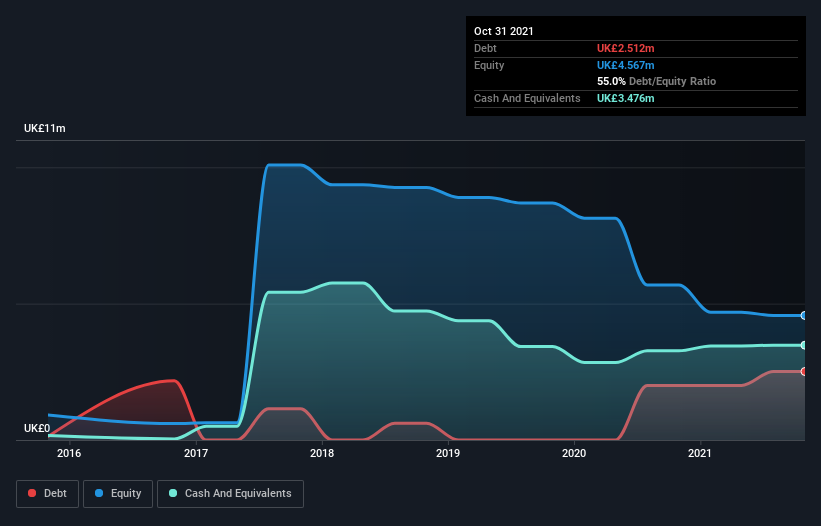- United Kingdom
- /
- Aerospace & Defense
- /
- AIM:VEL
Is Velocity Composites (LON:VEL) Weighed On By Its Debt Load?

David Iben put it well when he said, 'Volatility is not a risk we care about. What we care about is avoiding the permanent loss of capital.' When we think about how risky a company is, we always like to look at its use of debt, since debt overload can lead to ruin. Importantly, Velocity Composites plc (LON:VEL) does carry debt. But the real question is whether this debt is making the company risky.
What Risk Does Debt Bring?
Generally speaking, debt only becomes a real problem when a company can't easily pay it off, either by raising capital or with its own cash flow. If things get really bad, the lenders can take control of the business. However, a more usual (but still expensive) situation is where a company must dilute shareholders at a cheap share price simply to get debt under control. Having said that, the most common situation is where a company manages its debt reasonably well - and to its own advantage. The first step when considering a company's debt levels is to consider its cash and debt together.
Check out our latest analysis for Velocity Composites
What Is Velocity Composites's Net Debt?
As you can see below, at the end of October 2021, Velocity Composites had UK£2.51m of debt, up from UK£2.00m a year ago. Click the image for more detail. But it also has UK£3.48m in cash to offset that, meaning it has UK£964.0k net cash.

How Healthy Is Velocity Composites' Balance Sheet?
The latest balance sheet data shows that Velocity Composites had liabilities of UK£1.88m due within a year, and liabilities of UK£3.24m falling due after that. Offsetting these obligations, it had cash of UK£3.48m as well as receivables valued at UK£2.50m due within 12 months. So it can boast UK£860.0k more liquid assets than total liabilities.
This surplus suggests that Velocity Composites has a conservative balance sheet, and could probably eliminate its debt without much difficulty. Simply put, the fact that Velocity Composites has more cash than debt is arguably a good indication that it can manage its debt safely. When analysing debt levels, the balance sheet is the obvious place to start. But you can't view debt in total isolation; since Velocity Composites will need earnings to service that debt. So if you're keen to discover more about its earnings, it might be worth checking out this graph of its long term earnings trend.
Over 12 months, Velocity Composites made a loss at the EBIT level, and saw its revenue drop to UK£9.8m, which is a fall of 28%. That makes us nervous, to say the least.
So How Risky Is Velocity Composites?
While Velocity Composites lost money on an earnings before interest and tax (EBIT) level, it actually generated positive free cash flow UK£261k. So taking that on face value, and considering the net cash situation, we don't think that the stock is too risky in the near term. With mediocre revenue growth in the last year, we're don't find the investment opportunity particularly compelling. The balance sheet is clearly the area to focus on when you are analysing debt. However, not all investment risk resides within the balance sheet - far from it. We've identified 3 warning signs with Velocity Composites (at least 1 which is significant) , and understanding them should be part of your investment process.
At the end of the day, it's often better to focus on companies that are free from net debt. You can access our special list of such companies (all with a track record of profit growth). It's free.
New: Manage All Your Stock Portfolios in One Place
We've created the ultimate portfolio companion for stock investors, and it's free.
• Connect an unlimited number of Portfolios and see your total in one currency
• Be alerted to new Warning Signs or Risks via email or mobile
• Track the Fair Value of your stocks
Have feedback on this article? Concerned about the content? Get in touch with us directly. Alternatively, email editorial-team (at) simplywallst.com.
This article by Simply Wall St is general in nature. We provide commentary based on historical data and analyst forecasts only using an unbiased methodology and our articles are not intended to be financial advice. It does not constitute a recommendation to buy or sell any stock, and does not take account of your objectives, or your financial situation. We aim to bring you long-term focused analysis driven by fundamental data. Note that our analysis may not factor in the latest price-sensitive company announcements or qualitative material. Simply Wall St has no position in any stocks mentioned.
About AIM:VEL
Velocity Composites
Provides engineered composite material kits and related products to the aerospace industry in the United Kingdom, Europe, the United States, and internationally.
Good value with reasonable growth potential.
Market Insights
Community Narratives



